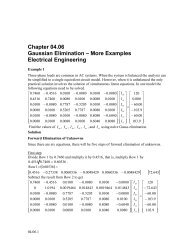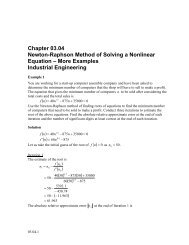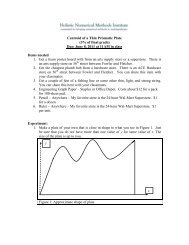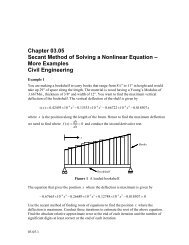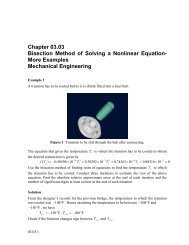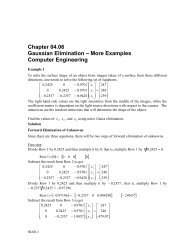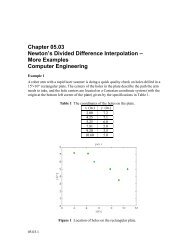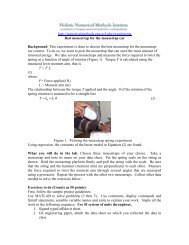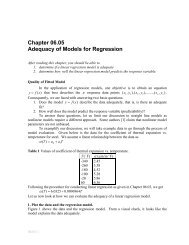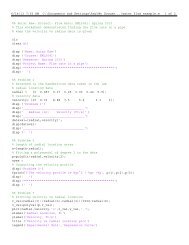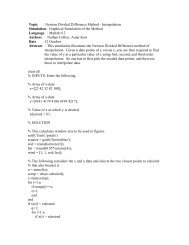xiii Note to the reader: This is a customized book for Old Dominion ...
xiii Note to the reader: This is a customized book for Old Dominion ...
xiii Note to the reader: This is a customized book for Old Dominion ...
You also want an ePaper? Increase the reach of your titles
YUMPU automatically turns print PDFs into web optimized ePapers that Google loves.
What do you mean by <strong>the</strong> rank of a set of vec<strong>to</strong>rs?Prove that if a set of vec<strong>to</strong>rs contains <strong>the</strong> null vec<strong>to</strong>r, <strong>the</strong> set of vec<strong>to</strong>rs <strong>is</strong> linearlydependent.Prove that if a set of vec<strong>to</strong>rs are linearly independent, <strong>the</strong>n a subset of <strong>the</strong> m vec<strong>to</strong>rs alsohas <strong>to</strong> be linearly independent.Prove that if a set of vec<strong>to</strong>rs <strong>is</strong> linearly dependent, <strong>the</strong>n at least one of <strong>the</strong> vec<strong>to</strong>rs can bewritten as a linear combination of o<strong>the</strong>rs.Prove that if <strong>the</strong> dimension of a set of vec<strong>to</strong>rs <strong>is</strong> less than <strong>the</strong> number of vec<strong>to</strong>rs in <strong>the</strong> set,<strong>the</strong>n <strong>the</strong> set of vec<strong>to</strong>rs <strong>is</strong> linearly dependentHow can vec<strong>to</strong>rs be used <strong>to</strong> write simultaneous linear equations?What <strong>is</strong> <strong>the</strong> definition of <strong>the</strong> dot product of two vec<strong>to</strong>rs?Chapter 04.03 Binary matrix operationsHow do you add two matrices?How do you subtract two matrices?How do I multiply two matrices?What <strong>is</strong> a scalar product of a constant and a matrix?What <strong>is</strong> a linear combination of matrices?What are some of <strong>the</strong> rules of binary matrix operations?Commutative law of additionAssociative law of additionAssociative law of multiplicationD<strong>is</strong>tributive lawIs [A][B] = [B][A]?Chapter 04.04 Unary matrix operationsWhat <strong>is</strong> <strong>the</strong> transpose of a matrix?What <strong>is</strong> a symmetric matrix?What <strong>is</strong> a skew-symmetric matrix?What <strong>is</strong> <strong>the</strong> trace of a matrix?Define <strong>the</strong> determinant of a matrix.Is <strong>the</strong>re a relationship between det(AB), and det(A) and det(B)?Are <strong>the</strong>re some o<strong>the</strong>r <strong>the</strong>orems that are important in finding <strong>the</strong> determinant?Chapter 04.05 System of equationsMatrix algebra <strong>is</strong> used <strong>for</strong> solving systems of equations. Can you illustrate th<strong>is</strong> concept?A system of equations can be cons<strong>is</strong>tent or incons<strong>is</strong>tent. What does that mean?How can one d<strong>is</strong>tingu<strong>is</strong>h between a cons<strong>is</strong>tent and incons<strong>is</strong>tent system of equations?If a solution ex<strong>is</strong>ts, how do we know whe<strong>the</strong>r it <strong>is</strong> unique?If we have more equations than unknowns in [A] [X] = [C], does it mean <strong>the</strong> system <strong>is</strong>incons<strong>is</strong>tent?Can I use <strong>the</strong> concept of <strong>the</strong> inverse of a matrix <strong>to</strong> find <strong>the</strong> solution of a set of equations[A] [X] = [C]?How do I find <strong>the</strong> inverse of a matrix?Is <strong>the</strong>re ano<strong>the</strong>r way <strong>to</strong> find <strong>the</strong> inverse of a matrix?If <strong>the</strong> inverse of a square matrix [A] ex<strong>is</strong>ts, <strong>is</strong> it unique?Chapter 04.06 Gaussian elimination 220How are a set of equations solved numerically? 220Forward elimination of unknowns 220Back substitution 222xvii



